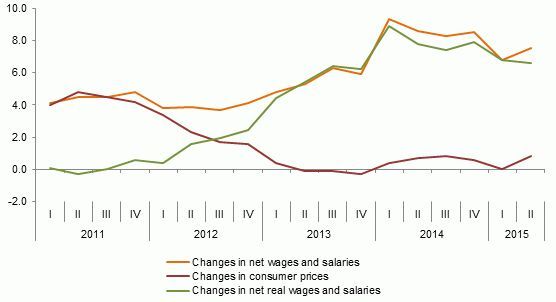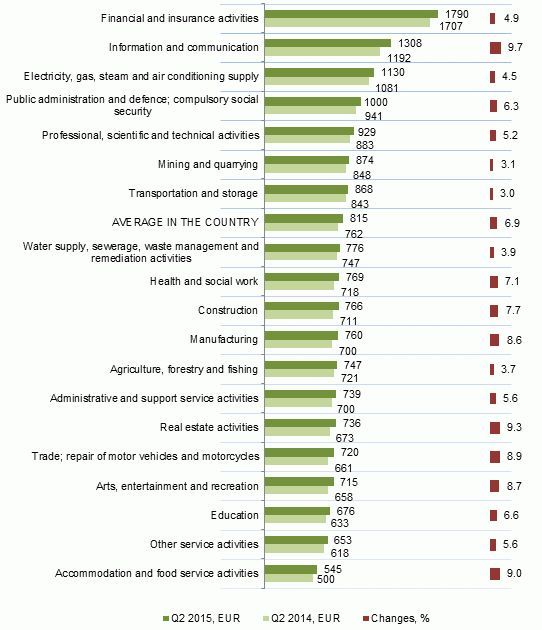Analytics, Financial Services, Latvia, Markets and Companies, Wages
International Internet Magazine. Baltic States news & analytics
Friday, 26.04.2024, 04:27
In Q2, average monthly gross wages and salaries in Latvia – 815 euros
 Print version
Print version
Compared to the 2nd quarter of the previous year, they have increased by 6.9%, slightly overtaking annual increase rate of 6.3%* in the 1st quarter of this year.
In private sector the average monthly wages and salaries amounted to euros 792, in public sector – euros 857, and in general government sector – euros 795. In private sector wages and salaries rose by 7.8% annually, and in public sector – by 5.3%.
Changes in average monthly gross wages and salaries by sector (euros)
|
|
Q2 2014 |
Q1 2015 |
Q2 2015 |
Changes, % |
|
|
Q2 2015 over Q2 2014 |
Q2 2015 over Q1 2015 |
||||
|
Total |
762 |
786* |
815 |
6.9 |
3.6 |
|
Private sector |
735 |
774* |
792 |
7.8 |
2.4 |
|
Public sector |
814 |
808* |
857 |
5.3 |
6.0 |
|
of which: |
|
|
|
|
|
|
General government sector |
744 |
756* |
795 |
6.9 |
5.2 |
Compared to the 2nd quarter of the last year, in the 2nd quarter of this year gross wages fund rose by 6.8% or 114.0 mln euros, the number of salaried employees in the country recalculated in normal (full-time) units decreased by 0.2 thsd.
In the 2nd quarter of 2015 the average monthly net wages and salaries accounted for 600 euros, and over the year they rose more rapidly than wages and salaries before taxes – by 7.5%. It can be explained with reduction of Personal Income Tax from 24% to 23% as of 1 January 2015. Since the beginning of this year also the minimum wage in the country has changed – from 320 euros to 360 euros (increase of 12.5%), which affected changes in the average wages and salaries.
In the 2nd quarter of this year the real increase of annual net wages and salaries, considering rise of consumer prices of 0.8%, constituted 6.6%. For the third year running low level of inflation does not affect real wages significantly, and thus it had no significant effect on purchasing power of the working population, too.
 |
| Changes in consumer prices and average monthly net wages and salaries (% over corresponding period of previous year) |
Data source: Central Statistical Bureau of Latvia
In the 2nd quarter of 2015 the largest average wages and salaries were registered in financial and insurance activities sector, information and communication services, energy sector and public administration. In turn, the lowest average wages and salaries were observed in accommodation, food and other service activities sectors, education, art, entertainment and recreation sectors, trade as well as in real estate activities.
In the 2nd quarter of this year, compared to the 2nd quarter of 2014, average gross wages rose in all sectors. The most rapid growth was recorded in information and communication services sector – of 9.7% annually, in real estate activities sector – of 9.3%, in accommodation and food services sector – of 9.0% and in trade – of 8.9%.
Over the year wages fund in real estate activities grew, while the number of employees recalculated in normal (full-time) units decreased. In turn, in the remaining above-mentioned sectors wages fund grew more rapidly than the number of employees.
Reduction in the number of full-time employees was also observed in manufacturing, construction, energy, water supply, sewerage, waste management and remediation activities, agriculture and mining.
 |
| Changes in average monthly gross wages and salaries |
Data source: sample survey of individual merchants, commercial companies, state and local government institutions, foundations, associations and funds as well as administrative data sources.
More information on wages and salaries in Latvia is available in the CSB database section Labour remuneration.
Explanations
*Data are revised.
Public sector is central and local government institutions and their commercial companies, companies with central or local government capital participation 50% and over, as well as foundations, associations, funds, and their commercial companies. Data on foundations, associations and funds and their commercial activities are not included in information.
According to the European System of Accounts the general government sector includes central and local government institutions, the social security fund, enterprises controlled and financed by the central and local governments.
Changes of the average monthly wages and salaries are calculated as not-rounded
values, i.e., taking into account the value in cents.
When calculating average monthly wages and salaries the number of salaried
employees is re-calculated into full-time units, thus eliminating the
differences in salaries paid for various workloads.








 «The Baltic Course» Is Sold and Stays in Business!
«The Baltic Course» Is Sold and Stays in Business!

